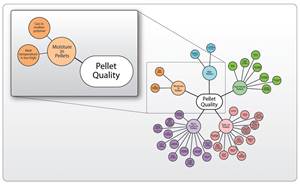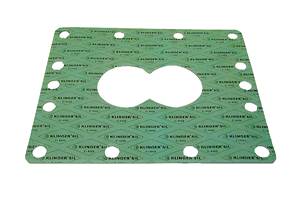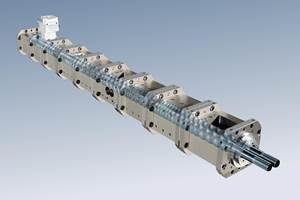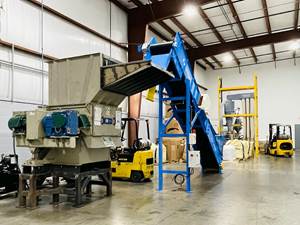Compounding & Mixing at NPE 2003
Torque levels and output capacities of corotating twin-screw compounders coming to NPE are higher than ever.
Torque levels and output capacities of corotating twin-screw compounders coming to NPE are higher than ever. The most recent news comes from Japan Steel Works (JSW), which is increasing its U.S. market presence with the establishment of a sales and technical center in the Midwest. JSW will show a new “ultra-high-torque” line of i-Tex corotating twin-screw compounders with 20% higher torque than the previous D-Tex models that were built here under license by Davis-Standard until three years ago.
There are also some unusually flexible corotating twin-screw lab lines on display. German Technology Imports’ new GIGA-34 lab model has 80 hp and can function like two different machines. At under 800 rpm, it’s a lab line. At 1800 rpm, it’s a pilot plant capable of compounding up to 800 lb/hr.
Labtech Engineering Co. in Thailand is bringing a new 26-mm corotating twin-screw extruder that’s four machines in one. It has interchangeable barrels for single- or twin-screw operation, both in 32:1 and 40:1 L/D.
Though not brand-new, one of the most unusual mixing devices at NPE is the 12-screw Ring Extruder from 3+ in Germany. At the show, its U.S. representative, Century Extruders, is raffling a chance to use the machine for trials in your own facility later this year.
Pelletizers advance
As filler levels and abrasiveness increase, compounders are chewing through pelletizer knives and dies at an ever-growing clip. Several show exhibitors are offering knife-sharpening and hardening services. But one of the more novel developments in the battle against abrasion is a patented ceramic pelletizer die and die plate from Econ GmbH in Austria. Believed to be the world’s first, it will run recycled PE at Starlinger’s booth.
In other pelletizer developments, Scheer Bay Co., a U.S. partner of C.F. Scheer in Germany, will show a new 15-strand lab pelletizer with a high-speed option that lets it cut up to 300 ft/min or 1300 lb/hr. Meanwhile, Conair’s new Model 216 increases output 30% by adding 30% more strands.
Abrasive materials and higher throughput are also noisy, so pelletizers are getting added sound deadening. Cumberland’s Super Quietizer strand pelletizer muffles the infeed and encloses the pelletizer with acoustic foam. The same features are available on a comparable new AEC model. Dynisco’s redesigned WRP 12i water ring pelletizer also boasts lower sound levels, higher throughput, and more uniform pellet size.
Static mixers haven’t changed much in recent years, but there is a new supplier at NPE that has licensed new manufacturing technology from Bayer in Germany that reportedly makes the mixers very much stronger and more resistant to crushing on cold start-up. Stamixco LLC says the Bayer process also allows the mixers to be made and sold at lower cost.
Higher mixing intensity
If it’s speed you’re after, Draiswerke is introducing a Gelimat thermokinetic batch mixer that delivers batches of compound in just 5 to 20 sec, thus providing an extremely short heat history. An electronic temperature sensor tells when compounding is complete and ejects the batch through a discharge door into a melt pump, short extruder, or calender. Draiswerke says the Gelimat is well suited to mixing recycled plastic with wood flour or other organic or inorganic fibers.
Related Content
The Path to Pellet Perfection
In underwater pelletizing, numerous variables in the equipment, process and material affect pellet shape, consistency and quality factors such as fines. Defining the “perfect” pellet depends on the conditions of end use, and achieving that ideal requires understanding of the causes of imperfections.
Read More10 Ways to Improve Twin-Screw Compounding Performance
There are many techniques known to operators and plant engineers for increasing the performance of a twin-screw compounding extruder.
Read MoreHow to Configure Your Twin-Screw Barrel Layout
In twin-screw compounding, most engineers recognize the benefits of being able to configure screw elements. Here’s what you need to know about sequencing barrel sections.
Read MoreEngineering Resins Compounder Expands to Take on More Scrap
Polymer Resources responds to sustainability push by upgrading plant with grinding and shredding equipment to take on both postindustrial and postconsumer reclaim.
Read MoreRead Next
Why (and What) You Need to Dry
Other than polyolefins, almost every other polymer exhibits some level of polarity and therefore can absorb a certain amount of moisture from the atmosphere. Here’s a look at some of these materials, and what needs to be done to dry them.
Read MoreUnderstanding Melting in Single-Screw Extruders
You can better visualize the melting process by “flipping” the observation point so that the barrel appears to be turning clockwise around a stationary screw.
Read MoreAdvanced Recycling: Beyond Pyrolysis
Consumer-product brand owners increasingly see advanced chemical recycling as a necessary complement to mechanical recycling if they are to meet ambitious goals for a circular economy in the next decade. Dozens of technology providers are developing new technologies to overcome the limitations of existing pyrolysis methods and to commercialize various alternative approaches to chemical recycling of plastics.
Read More









.png;maxWidth=300;quality=90)















